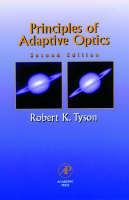
Principles of Adaptive Optics
Academic Press Inc (Verlag)
978-0-12-705902-0 (ISBN)
- Titel ist leider vergriffen;
keine Neuauflage - Artikel merken
Principles of Adaptive Optics is a comprehensive guide to adaptive optics systems and components. It covers all the basic principles, analytical tools, and instrumentation hardware included in an adaptive optics system. This single volume resource includes hundreds of references and outlines design and performance analysis of adaptive optics wavefront sensors, controls, correcting optics, and their integrated operation. The book discusses adaptive optics, system analysis and system design, and the major subsystems: wavefront sensors, correcting optics, wavefront reconstructors, and real-time controls. It details the principal equations that govern atmospheric turbulence compensation. The book contains nearly 700 citations that cover a quarter century of research and development. It includes a new section on laser guide stars and their usage. It also includes recently declassified military information on laser guided stars and all the governing equations of wavefront error, imaging system resolution, beam tilt or wander, scintillation, temporal spectra, anisoplantism, and guide star position.
Robert K. Tyson holds a Ph.D. in Physics and MS in Physics from West Virginia University and a BS in Physics from Penn State University. Dr. Tyson has been a Senior Scientist at W.J. Schafer Associates, Inc. since 1987. He is currently supporting efforts in atmospheric propagation, space-based laser technology, astronomical instrumentation, and adaptive optics performance studies. He has contributed to technology development in the areas of wavefront sensors, deformable mirrors, microsurgical laser systems, and electronic countermeasures. Besides being the author of Principles of Adaptive Optics (Academic Press), he is the co-author of a chapter on adaptive optics in The Infrared & Electro-Optical Systems Handbook (ERIM & SPIE Press, Bellingham, Washington, 1993). He has more than twenty-five publications in the fields of optical aberration theory, adaptive optics systems, laser communications, medical imaging, and computer simulation technologies. He serves as a chairman of the SPIE International Technical Working Group on Adaptive Optics. Dr. Tyson was the invited lecturer at a University of Oxford physics colloquium in 1993 and lectured at Moscow State University in 1995. Before joining WJSA, Dr. Tyson was a Senior Project Engineer at United Technologies Optical Systems from 1978 1987. He was senior engineer in the Phased Array program office of United Technologies Optical Systems. He was technical director and deputy program manager of the Phased Array Concept Study and Brassboard (PACSBB) program for the Air Force Phillips Laboratory and BMDO. Prior to assignment to PACSBB, Dr. Tyson was manager and principal investigator of a number of beam control and optics contracts in both strategic and tactical areas.
History and Background: Introduction. History. Physical Optics: Propagation with Aberrations. Imaging with Aberrations. Representing the Wavefront. Interference. Adaptive Optics Terms. Sources of Aberrations: Atmospheric Turbulence: Descriptions of Atmospheric Turbulence. Refractive Index Structure Constant. Turbulence Effects. Turbulence MTF. Thermal Blooming: Blooming Strength and Critical Power. Turbulence, Jitter, and Thermal Blooming. Non-atmospheric Sources: Optical Misalignments and Jitter. Thermally Induced Distortions of Optics. Manufacturing and Microerrors. Other Sources of Aberrations. Adaptive Optics Compensation: Phase Conjugation. Limitations of Phase Conjugation: Turbulence Spatial Error. Turbulence Temporal Error. Sensor Noise Limitations. Thermal Blooming Compensation. Artificial Guide Stars. Combining the Limitations. Linear Analysis of Random Wavefronts. Linear Analysis of Deterministic Wavefronts: Partial Phase Conjugation. Adaptive Optics Systems: Adaptive Optics Imaging Systems. Beam Propagation Systems: Local Loop Beam Cleanup Systems. Alternative Concepts. Pros and Cons of the Various Approaches. Unconventional Adaptive Optics: Nonlinear Optics. Elastic Photon Scattering, DFWM. Inelastic Photon Scattering. System Engineering. Wavefront Sensing: Directly Measuring Phase: The Non-uniqueness of the Diffraction Pattern. Determining Phase Information from Intensity. Modal and Zonal Sensing. Direct Wavefront Sensing--Modal: Importance of Wavefront Tilt. Measurement of Tilt. Focus Sensing. Modal Sensing of Higher-Order Aberrations. Direct Wavefront Sensing--Zonal: Interferometiric Wavefront Sensing. Hartman Wavefront Sensors. Curvature Sensing. Selecting a Method. Indirect Wavefront Sensing Methods: Multidither Adaptive Optics. Image Sharpening. Wavefront Sampling: Beamsplitters. Hole Gratings. Temporal Duplexing. Reflective Wedges. Diffraction Gratings. Hybrids. Sensitivities of Sampler Concepts. Detectors and Noise. WavefrontCorrection: Modal Tilt Correction. Modal Higher-Order Correction. Segmented Mirrors. Deformable Mirrors: Actuation Techniques. Actuator Influence Functions. Bimorph Corrector Mirrors. Membrane and Micromachine Mirrors. Edge Actuated Mirrors. Large Correcting Optics. Special Correction Devices: Liquid Crystal Phase Modulators. Spatial Light Modulators. Charged-large-array-mirrors. Reconstruction and Controls: Introduction. Single-Channel Linear Control: Fundamental Control Tools. Transfer Functions. Proportional Control. First- and Second-Order Lag. Feedback. Frequency Response of Control Systems. Digital Controls. Multivariate Adaptive Optics Controls: Solution of Linear Equations. Direct Wavefront Reconstruction: Phase from Wavefront Slopes. Modes from Wavefront Slopes. Phase from Wavefront Modes. Modes from Wavefront Modes. Zonal Corrector from Continuous Phase. Modal Corrector from Continuous Phase. Zonal Corrector from Modal Phase. Modal Correctors from Modal Phase. Indirect Reconstructions.Modal Corrector from Wavefront Modes. Zonal Corrector from Wavefront Slopes. Spatiotemporal Considerations. Subject Index.
| Erscheint lt. Verlag | 8.10.1997 |
|---|---|
| Zusatzinfo | references, index |
| Verlagsort | San Diego |
| Sprache | englisch |
| Maße | 152 x 229 mm |
| Gewicht | 681 g |
| Themenwelt | Naturwissenschaften ► Physik / Astronomie ► Astronomie / Astrophysik |
| Naturwissenschaften ► Physik / Astronomie ► Optik | |
| Technik | |
| ISBN-10 | 0-12-705902-4 / 0127059024 |
| ISBN-13 | 978-0-12-705902-0 / 9780127059020 |
| Zustand | Neuware |
| Haben Sie eine Frage zum Produkt? |
aus dem Bereich


